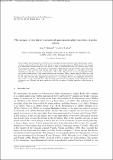Files in this item
The merger of two three-dimensional quasi-geostrophic baroclinic tripolar eddies
Item metadata
| dc.contributor.author | Reinaud, Jean Noel | |
| dc.contributor.author | Carton, Xavier | |
| dc.date.accessioned | 2022-02-26T00:37:04Z | |
| dc.date.available | 2022-02-26T00:37:04Z | |
| dc.date.issued | 2021 | |
| dc.identifier | 272488775 | |
| dc.identifier | 62d8898c-925a-41f2-b7cb-948ce9bf4723 | |
| dc.identifier | 85101781719 | |
| dc.identifier | 000622310600001 | |
| dc.identifier.citation | Reinaud , J N & Carton , X 2021 , ' The merger of two three-dimensional quasi-geostrophic baroclinic tripolar eddies ' , Geophysical and Astrophysical Fluid Dynamics , vol. 115 , no. 5-6 , pp. 523-550 . https://doi.org/10.1080/03091929.2021.1881780 | en |
| dc.identifier.issn | 0309-1929 | |
| dc.identifier.other | ORCID: /0000-0001-5449-6628/work/90567346 | |
| dc.identifier.uri | https://hdl.handle.net/10023/24956 | |
| dc.description.abstract | We investigate the strong interaction between two baroclinic tripolar eddies in a three-dimensional, rapidly- rotating, continuously stratified flow under the quasi-geostrophic approximation. Each tripolar eddy consists of an anticyclonic central vortex with two oblate cyclonic vortices located above and below the anticyclone. The interaction depends on the vertical and horizontal offsets between the two tripolar eddies. For small and low PV oblate cyclones, each tripolar eddy alone is only weakly unstable to a baroclinic mode. The instability puts the three vortices out of alignment. Most of the eddy however survives the instability. When two tripolar eddies interact, their constituent vortices may merge. Merger occurs when the eddies are close enough together, and shows similarities with the merger of monopolar vortices. Vertically separated eddies do not align vertically. This suggests the importance of an external flow for the alignment, observed in the oceans, to occur. We finally show that the interaction between two tripolar eddies with intense oblate cyclones is very different and show similarities with the dynamics of dipolar baroclinic eddies known as hetons. | |
| dc.format.extent | 28 | |
| dc.format.extent | 7475846 | |
| dc.language.iso | eng | |
| dc.relation.ispartof | Geophysical and Astrophysical Fluid Dynamics | en |
| dc.subject | Quasi-geostrophy | en |
| dc.subject | Vortex interactions | en |
| dc.subject | Vortex merger | en |
| dc.subject | QA Mathematics | en |
| dc.subject | QC Physics | en |
| dc.subject | QE Geology | en |
| dc.subject | T-NDAS | en |
| dc.subject.lcc | QA | en |
| dc.subject.lcc | QC | en |
| dc.subject.lcc | QE | en |
| dc.title | The merger of two three-dimensional quasi-geostrophic baroclinic tripolar eddies | en |
| dc.type | Journal article | en |
| dc.contributor.institution | University of St Andrews. Applied Mathematics | en |
| dc.contributor.institution | University of St Andrews. Scottish Oceans Institute | en |
| dc.identifier.doi | https://doi.org/10.1080/03091929.2021.1881780 | |
| dc.description.status | Peer reviewed | en |
| dc.date.embargoedUntil | 2022-02-26 |
This item appears in the following Collection(s)
Items in the St Andrews Research Repository are protected by copyright, with all rights reserved, unless otherwise indicated.

